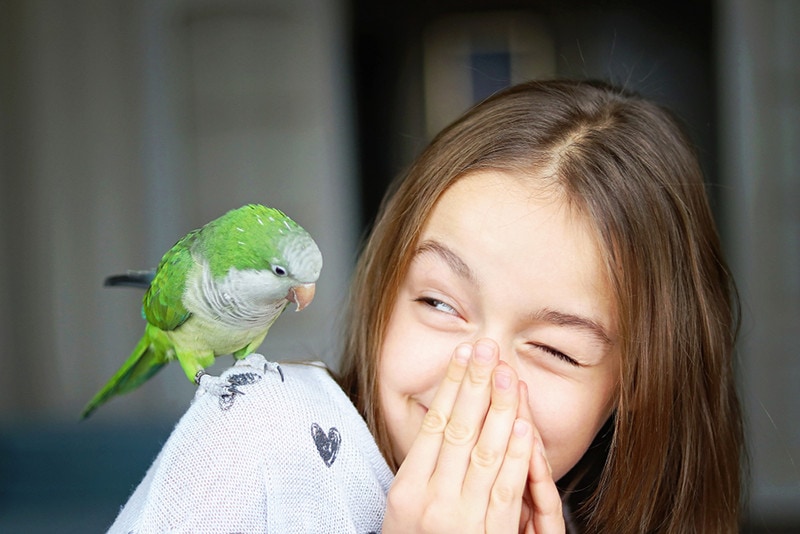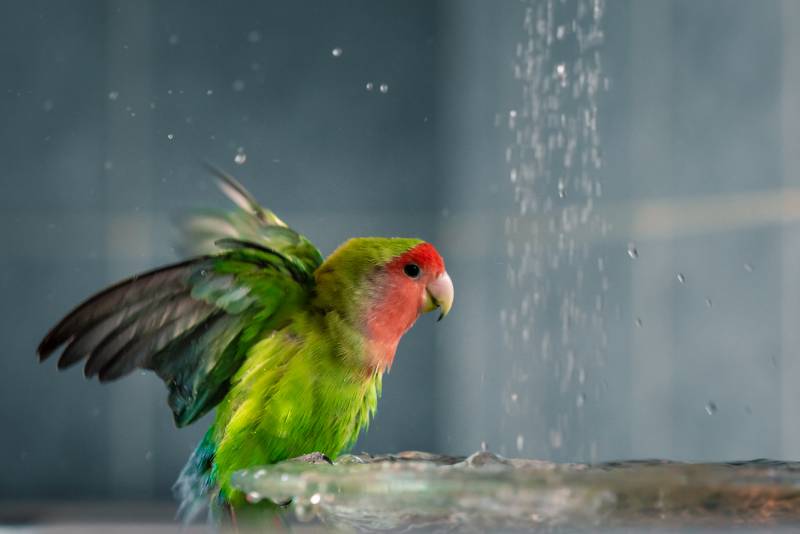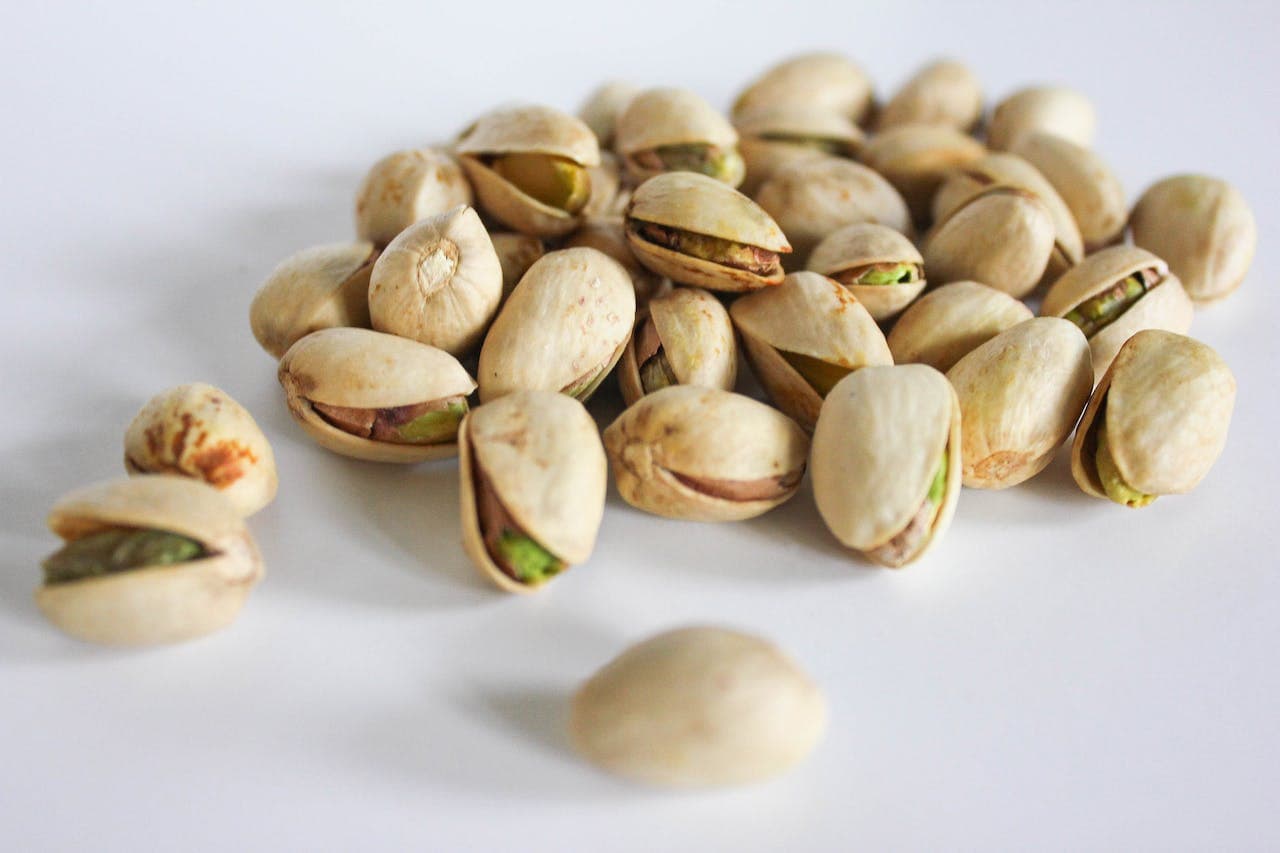7 Types of Finches Kept as Pets (With Pictures)
By Kit Copson
Updated on
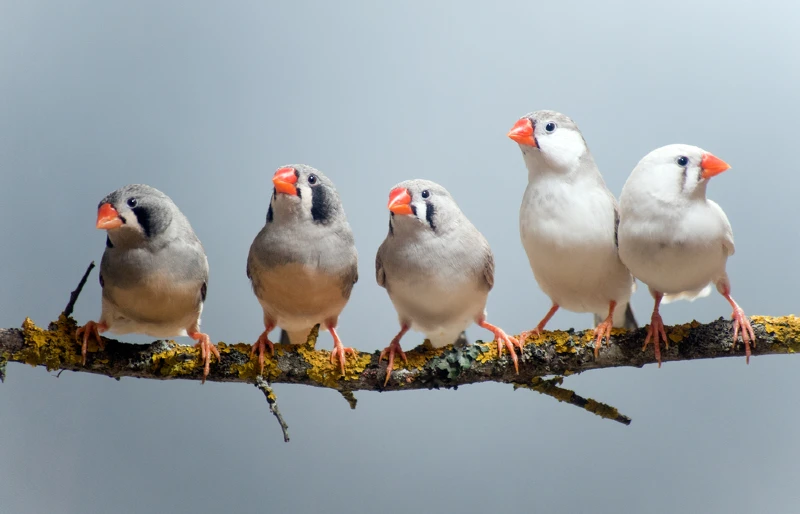
Finches are small, brightly colored, diverse, and social songbirds that have been capturing the hearts of bird lovers and charming multitudes with their songs for thousands of years. There are several finch types, but only a few of these are kept as pets.
Popular pet finch breeds include the domestic Canary, Gouldian Finch, Society Finch, and Zebra Finch, but there are more. This guide explores the various finch types bird lovers can raise.
How Are Pet Finches Classified?
There are around 240 species of true finches separated into three subfamilies and 50 genera. Given the large number of finch species and how diverse they are, it’s something of a challenge for taxonomists to categorize them all.
Pet finches typically come from the Estrildidae family, of which there are around 140 species. These birds are native to the Australasia region and the Old World (Afro-Eurasia) and include sparrows, weavers, and waxbills. Surprisingly, Estrildidae birds are not close relatives of other finch types, though the word “finch” is in the breed names.
Finches are small (though some may be categorized as small-to-medium), delicate birds with conical (cone-shaped) bills. This shape helps the finch to eat nuts and seeds, though some species eat insects, too. The body type can be rounded or long and slender, and the length of the body falls between 3 and 10 inches.
One of the most distinguishing and fascinating finch features is their diversity of bold, eye-catching colors, which range from subtle gray, brown, and white to bubblegum pink, letterbox red, lavender, and/or cheerful yellow depending on the species.
The 7 Pet Finch Types
1. Zebra Finch
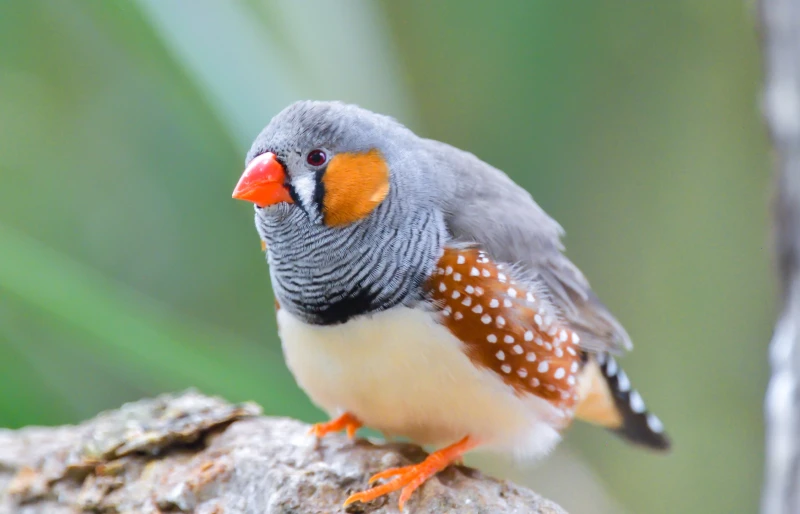
| Origin: | Australia |
| Lifespan: | 5–15 years |
| Length: | 4 inches |
The Zebra Finch is one of the most popular domestic finch types. These birds are gray with distinctive eye markings that resemble teardrops, and their throats and upper breasts are barred with black while the rump and upper tail are barred with black and white. The feathers are chestnut-colored with snowy white spots.
There are reddish-orange patches on the cheeks, and the beak and legs are orange. The beak is brighter in males than it is in females. As diurnal birds, Zebra Finches are most active during the day, and their habitat must be kept in darkness for around 10–12 hours to allow them to sleep.
Zebra Finches are social animals that thrive in pairs or small groups, and each male in a group has a song that is unique to them. They cannot thrive in environments with temperatures that fall below 60 degrees Fahrenheit.
2. Gouldian Finch

| Origin: | Australia |
| Lifespan: | Around 6 years |
| Length: | 5.5–6 inches |
The Gouldian finch is a grassfinch native to Northern Australia where it’s classified as endangered. This finch is identified by its rainbow-colored plumage; a purple breast, yellow belly, black (75%) or red (25%) face with a light blue ring, grass-green back, and blue tail. The beak is red-tipped. Female Gouldian Finches have more muted colors than bold males.
Gouldian Finches are dainty, timid birds that don’t usually like to be handled because they’re not entirely domesticated, so they’re not ideal for those looking for a bird that will hop onto their palm. They’re pretty quiet as a rule and vocalize with soft sounds rather than noisy ones. Like Zebra Finches, Gouldian Finches need to be kept in pairs or paired groups.
3. Society Finch

| Origin: | Asia |
| Lifespan: | 5–10 years |
| Length: | 4–5 inches |
Society Finches are among the most domesticated finches—they don’t occur in the wild at all—a fact which makes them popular companions for bird lovers. These generally easygoing, merry birds likely descended from the White-Rumped Munia and are sometimes referred to as Bengalese Finches.
These birds come in a number of color mutations with shades of chocolate brown, pied (the most common color), and fawn combined with white. “Selfs” are solid-colored Society Finches. Society Finches aren’t noisy but love to sing and, like the Zebra Finch, each has his own song. Dancing and singing simultaneously is a cute Society Finch quirk.
4. Orange Weaver Finch
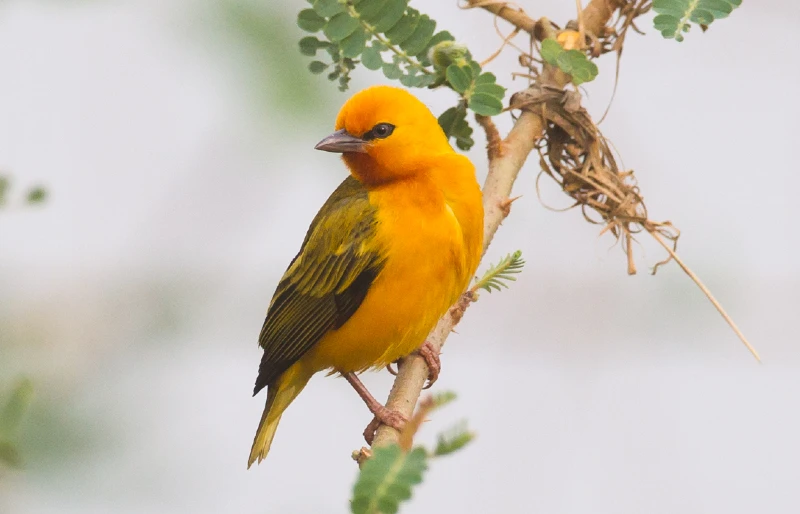
| Origin: | Africa |
| Lifespan: | 10–15 years |
| Length: | Up to 4.9 inches |
If one word could sum up the Orange Weaver’s temperament, it would be “feisty”. They’re active birds that are known for becoming aggressive during breeding season, which sometimes means they have to be removed from the group. They also like to build their own nests rather than accepting human-made ones.
For these reasons, Orange Weavers need a sizable aviary. In mixed environments, Orange Weavers do well with larger, sturdier finch breeds or at least finches the same size as the Orange Weaver itself.
Male Orange Weavers are bright red-orange in color on the head, chest, and tail, but this fades in the off-season. Females have a duller plumage (similar to a sparrow) and this doesn’t change.
5. Strawberry Finch
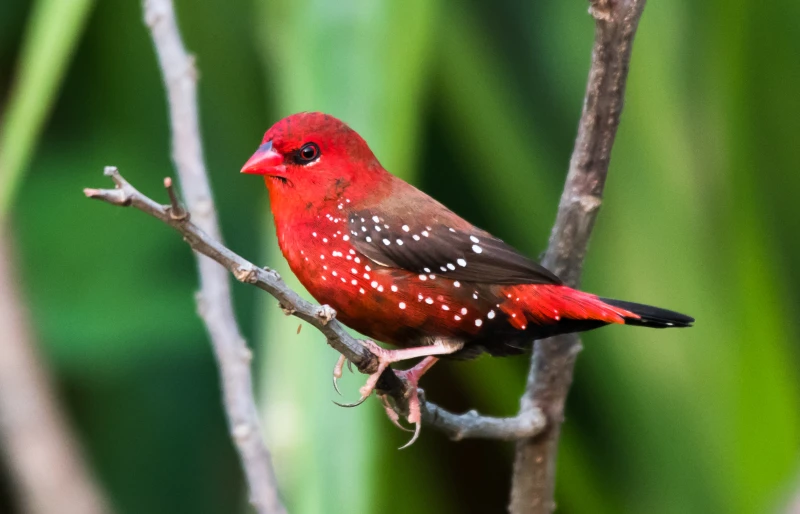
| Origin: | Asia |
| Lifespan: | 7–10 years |
| Length: | 3.6–4 inches |
How the Strawberry Finch (Red Avadavat) got its name is no mystery—the gorgeous red plumage and black wings spattered with white spots give the game away. Outside of the breeding season, this brilliant red fades to a reddish-brown color. The female, on the other hand, is a brown-grayish hue with fewer spots than the male, though a flash of red can be seen on the tail.
Both male and female Strawberry Finches sing, but the female is somewhat quieter. The sound of a Strawberry Finch’s song could be compared to the sound of a flute. Strawberry Finches can be quite territorial and do well in outdoor aviaries with plenty of greenery. They enjoy feasting on insects.
6. Star Finch
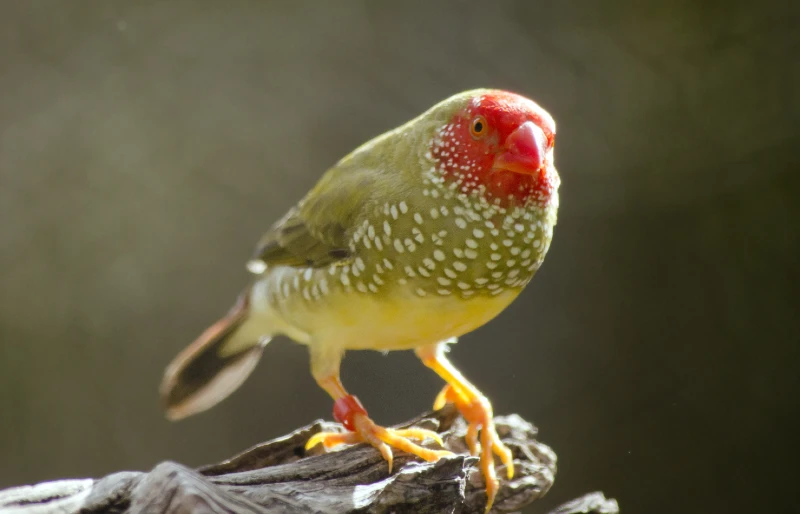
| Origin: | Australia |
| Lifespan: | 4–8 years |
| Length: | Up to 4.7 inches |
With its green plumage, yellow belly, red face, and white spots, the Star Finch from northern Australia is a real head-turner and a popular domestic bird. As is the case with other finches, the female Star Finch has duller colors. On a female, the yellow on the belly is more faded and there is less color on the head.
Star Finches are commonly kept in aviaries and are said to be peaceful yet timid, which is a common finch trait. They’re also quite adaptable, quickly making themselves at home in most aviaries. However, they appreciate warm, dry environments, so their aviary should not be well-sheltered from cold, wet, and damp conditions.
7. Plum-headed Finch
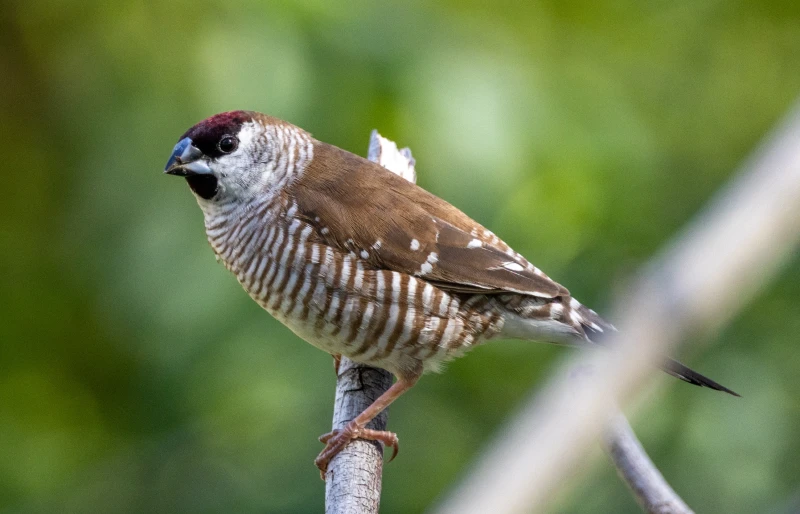
| Origin: | Australia |
| Lifespan: | 6–8 years |
| Length: | 5.9 inches |
The Plum-headed Finch is sometimes overlooked by avian enthusiasts because it’s not as common and less brightly colored than many other species. Nevertheless, some are fond of Plum-headed Finches for their easygoing temperaments, adaptability, and charm. They’re said to be quite tame, non-aggressive, and generally a joy to keep, so you might want to give this underdog a chance.
The Plum-headed Finch is brown in color with white spots, white and brown zebra-like barring on the chest and belly, a white face, and a beautiful pop of red on top of the head. Males also have a reddish-brown bib beneath their beaks. The body is plump, but the tail is long.
Are Finches Good Beginner Birds?
Yes and no. Finches are relatively easy to look after, but, like all birds, there’s a lot to take into account when it comes to caring for them properly.
- Aviary or cage maintenance
- Ensuring that the habitat is the ideal size for the bird’s well-being
- Providing mates or small groups as necessary
- Making sure the enclosure has everything the birds need to thrive (bedding, bathing items, UVB lighting if necessary)
- Providing a proper diet and clean water
- Providing toys
- Making sure the bird has space to exercise
- Getting the birds’ nails trimmed as necessary (it’s best to let a professional do this)
- Taking time to interact with the birds to let them get used to you
Conclusion
If you’re a finch fan, there are plenty of types that adapt well to domestic life. Nevertheless, despite their reputation for being easy to care for, raising finches is still a big commitment.
These delicate animals need high standards of welfare (food, environment, etc.) and plenty of opportunities for enrichment to thrive, so make sure you’re up for the commitment before you bring some home.
Featured Image Credit: Natia Tsuleiskiri, Shutterstock

